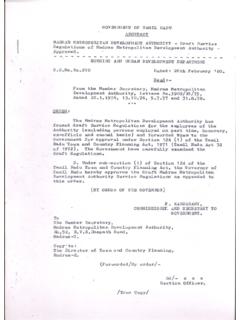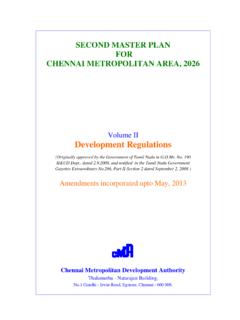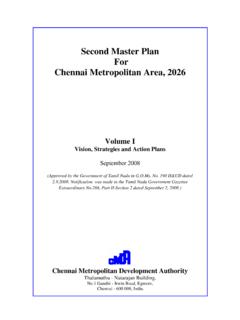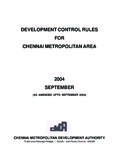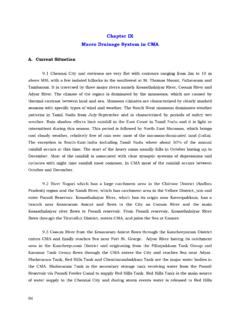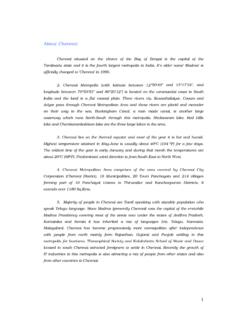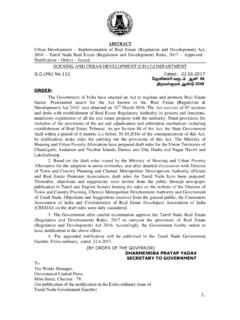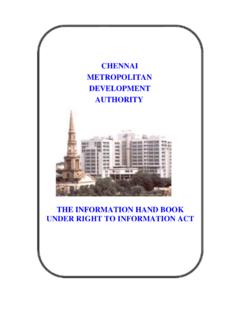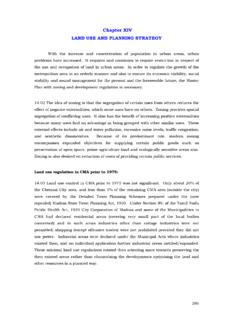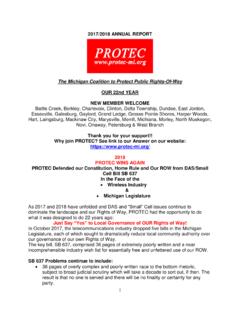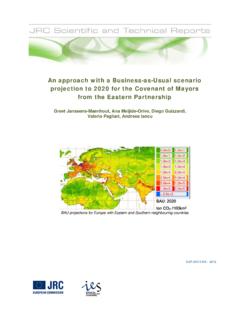Transcription of Session – I Getting the City Back to the People Municipal ...
1 55 Session I Getting the City Back to the People Municipal initiative in heritage conservation - The Case of Ahmedabad Thiru Debashish Nayak, Advisor, heritage Programme, Ahmedabad Municipal Corporation State Project Coordinator, Gujarat National Mission on Monuments & Antiquities, Archaeological Survey of India Introduction: Communities live and work in towns and cities; society changes so does urban form, responding to accommodate and change and growth. In today s pace of economic development, such historic resources ate often perceived as inefficient unproductive and even inconvenient. They are often replaced with buildings that appear contemporary and more efficient. This neglect has led to decay, depressed economic conditions and dilapidation leading to migration of the population to newer areas. Familiarity breeds contempt.
2 The citizens get accustomed with their environment and gradually become less aware of it. The city becomes a habit. Here in lies the need to make the citizens aware of the importance of their built environment and to help them develop a harmonious and contemporary relationship with it. In a sense, urban renewal does not just rebuild the city, it rebuilds People s relationship with the city. Their lies a need that the old buildings and older areas of the city should be looked upon as assets rather than as liabilities because they represent the history of communities, embodying their tradition, heritage and culture through architecture and the urban form. This paper explains the importance of an alternative way of connecting conservation and community participation for a sustainable process of revival for Historic cities in India.
3 Role of Municipal Corporations in heritage conservation : The local government plays a very important role in the whole implementation process and the achievement of the ultimate goal of an integrated heritage conservation effort. THE AHMEDABAD initiative Background The birth of the Old City settlement dates back to a 10th century AD town known as Ashaval. In the later part of the 11th century, another city grew adjacent to Ashaval, known as Karnavati. The present Walled City was created during the Ahmed Shahi period in the 15th century. A new palace and fort were built near Bhadra, which covered a rectangular area of around 500 * 800 meters. During the 17th and l8th centuries, the city expanded outwards. Fortifications were strengthened. The 18th century saw the decline of the city and many suburbs 56and even parts of the inner city were abandoned and ruined.
4 During the British rule due to political stability and later the introduction of textile mills resulted in economic growth and prosperity. Military and administrative centers, cantonment and railways churches, administrative and residential buildings were also established during the period. Wholesale Markets at Kalupur, mechanized industries and worker s quarters on eastern suburbs, Ellis Bridge, Residential buildings abd educational institutions were established. For walls were mostly pulled down in mid 20th century. The absence of any decentralization policy with regard to economic activities resulted in congestion and decay of Walled city. Urban Character Streets and Neighborhoods: The nucleus of activities at Bhadra and Manek Chowk and the twelve gates on the wall, created a radial pattern of streets.
5 Puras were connected with wider streets and entered through gates. Each micro neighborhood around residential streets became typical and is called pol which consists of a street and houses on its both sides. It would have at the most two gates that bat entry at night. The city of Ahmedabad has been able to display examples worth replicating in the field of heritage conservation . AMC and Ford Foundation, New Delhi prepared a report on Urban conservation of Walled City Ahemedabad . The study concentrated on the essential elements required in the city s conservation with a focus on the historical areas. The historical importance of the city, city form, wall, gates, pols, house patterns and the problems related to old fabric were analyzed. A list of heritage buildings and precincts was prepared. A conservation and a demonstration project were also proposed.
6 Sharing the Concerns: In the initial phase of intervention an attempt was made to identify the various factors making conservation of heritage difficult in the Walled City area. Some of these issues are listed below: Problems in regulations and policies: Road Line: During the British rule a proposal was mooted for widening the roads in the Walled City. Proposed road boundaries, known as Road Lines were demarcated. All new construction was to be done beyond this line. This created a negative attitude among the community members with the result that the front portion of the building, coming under road line has been neglected. This has resulted in the decay of many a valuable building facades. Floor Space Index (FSI): The permissible FSI in the Walled City, except for the City Centre area was The traditional neighbourhoods normally consume much less.
7 This additional FSI is actually being used for constructing multi-storied buildings by amalgamating three or tour plots. This used to 57destroy the character of the area. Now it has been reduced to , so the only development possible is restoration and upgrading the existing property. Tax Structure: Certain aspects of the Tax structure do not favour heritage conservation . For example, Chabutaras (bird feeder) are considered as commercial buildings and are taxed on such rates. Similarly, vacant properties are taxed less, leading to buildings of heritage value being locked up and left to ruin. Changes in the Economy Closure of Textile mills: A large part of the residential population in the Walled City consisted tenants working in textile mills. With the mills closing down, they were rendered jobless and stopped maintaining the old buildings that they occupied.
8 This led to a variety of heritage properties Getting ruined. Growth of gold and silver units: The gold and silver industry in the Walled City grew and attracted many skilled persons into the fabric. This influx of People from outside has disturbed the homogeneity of the social fabric in pols. This is also suspected to have increased the crime rate in the Walled City. Commercial ingress in the old fabric, especially after the addition of Relief Road, created a lot of undesirable changes in the landuse. Warehouses coming up inside the pols greatly disturbed the residential character. Social problems leading to migration: Successive riots and communal problems have forced People to migrate thus weakening the upkeep of the fabric. Lack of information Awareness among the People about conservation is very poor. Also the unavailability of proper building materials for repair works caused decay.
9 Proper maps and drawings of the Walled City were not available. This reduces the access of the police, fire force, ambulances, etc. into the deeper portions of the city. Strategic Partnerships The success of any intervention depends on the building of strategic and in stimulating widespread participation of a variety of stakeholders. Community Participation A serious of activities were organized to elicit community participation. Some of these are described below: 58A meeting at Khadia: A meeting was held in the Old City Khadia area to discuss the possibilities and strategies of conservation and development of Walled City of Ahmadabad. This was organized by AMC and attended by many citizen groups, renowned personalities and AMC officials. World heritage Week Celebration at Desai-ni-Pol: The first public programme entitled Preservation of the Past and Glimpses of History was launched at Desai-ni-Pol in Khadia area on 19th November 1996 on the occasion of World heritage Week celeberation.
10 This was a unique programme where heritage was the main issue and organized jointly by citizens groups and Municipal authorities. Desai-ni-Pol has a place in history because of its rebellious past during the British rule. The residents of the pol released a booklet to mark the heritage Day, listing the historical houses, personalities who lived there, and a chronicle of important events. Krantidarshafl Padyatra (Freedom Walk): On 14 August 1997 a Freedom Walk was organized where several houses, connected with the history of Indian freedom struggle came to light. Twenty-eight important houses were identified and the citizens under the leadership of elected and government officials visited the same. Based on this on 2 October 1997, many pol groups celebrated Gandhiji s birthday and buildings associated were visited. Netaji s birthday celebrated in Bengal Home: A celebration similar to that in Desai-ni-Pol marked the birthday of Netaji Subhash Chandra Bose on 23 January 1998.
